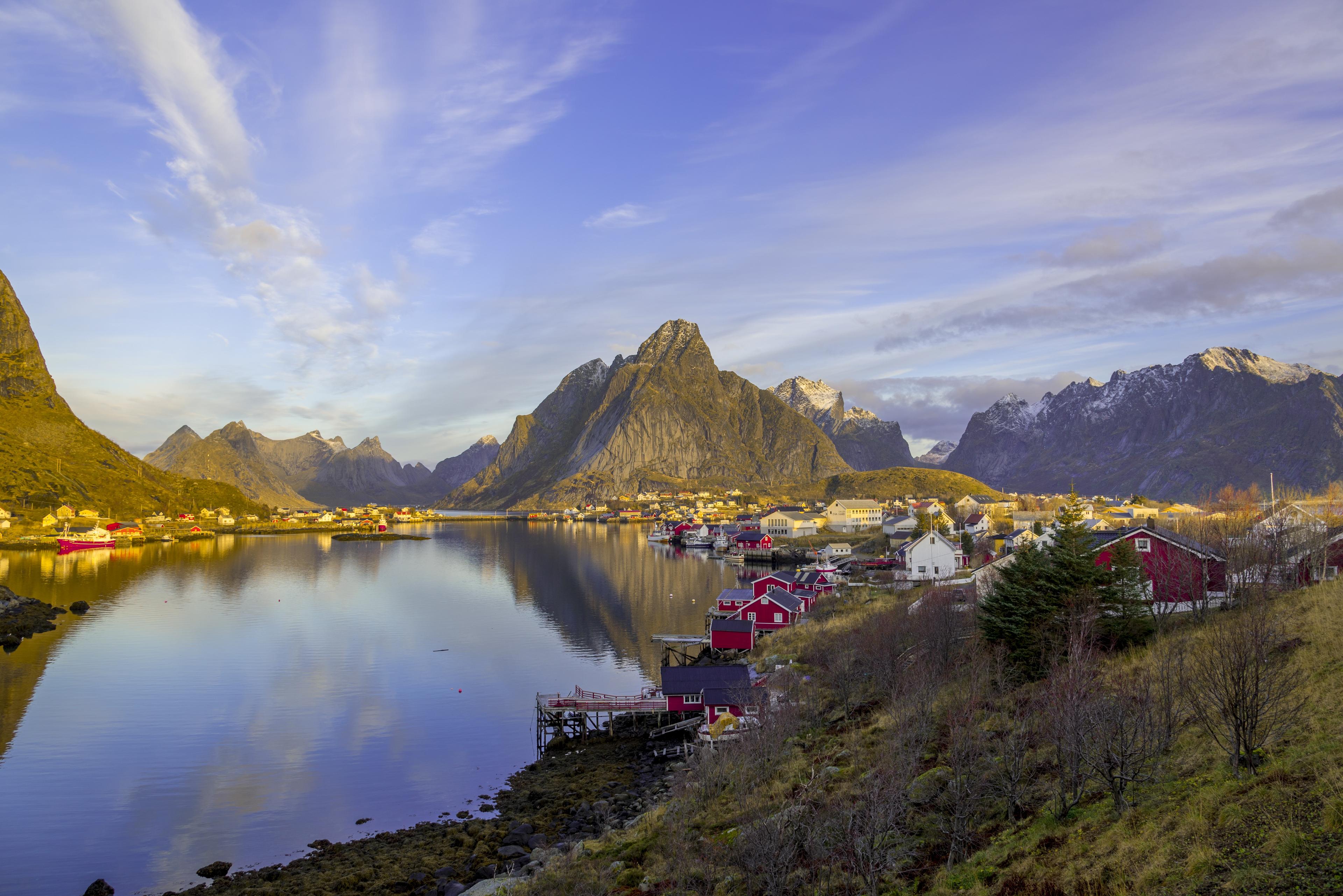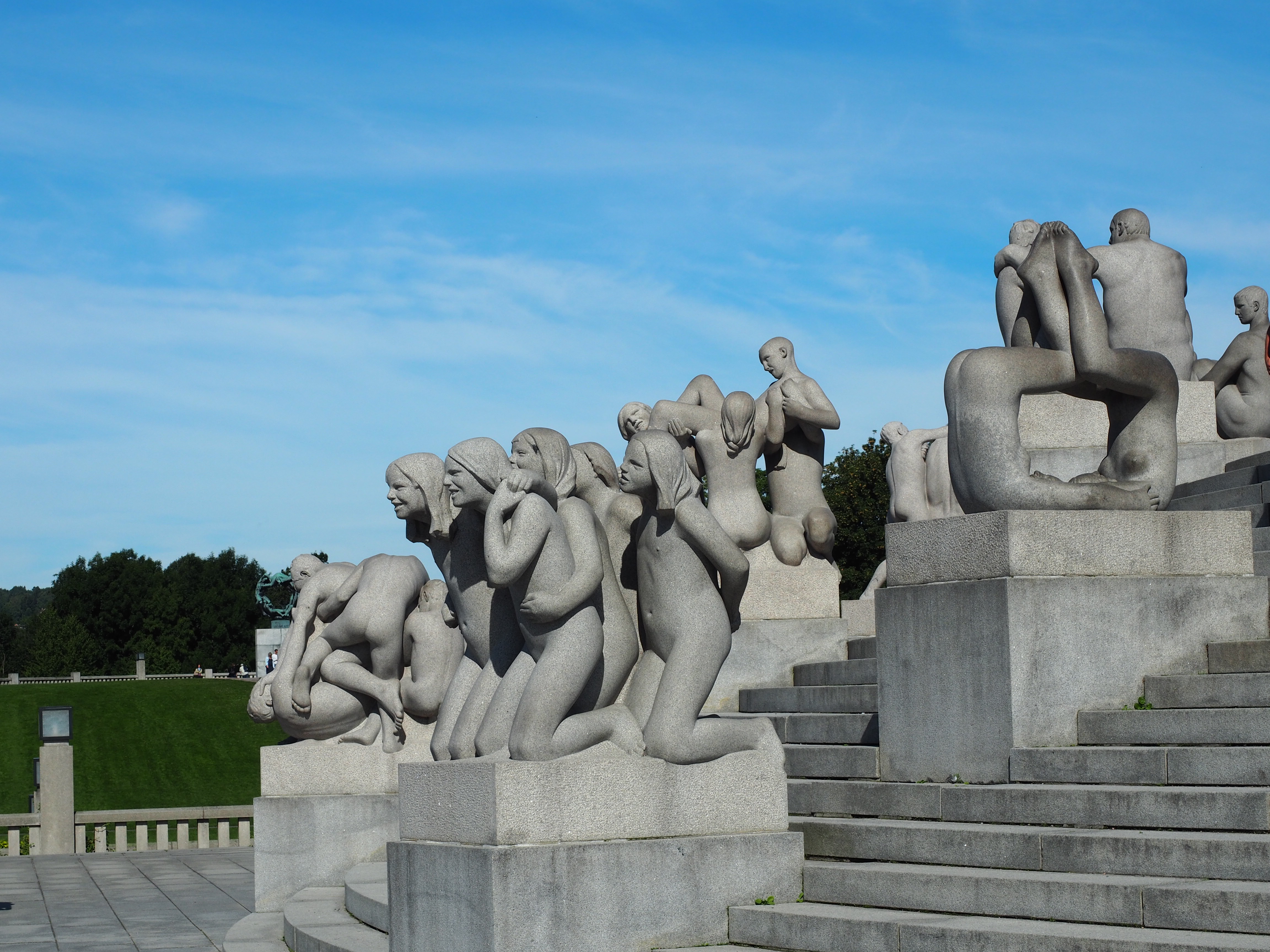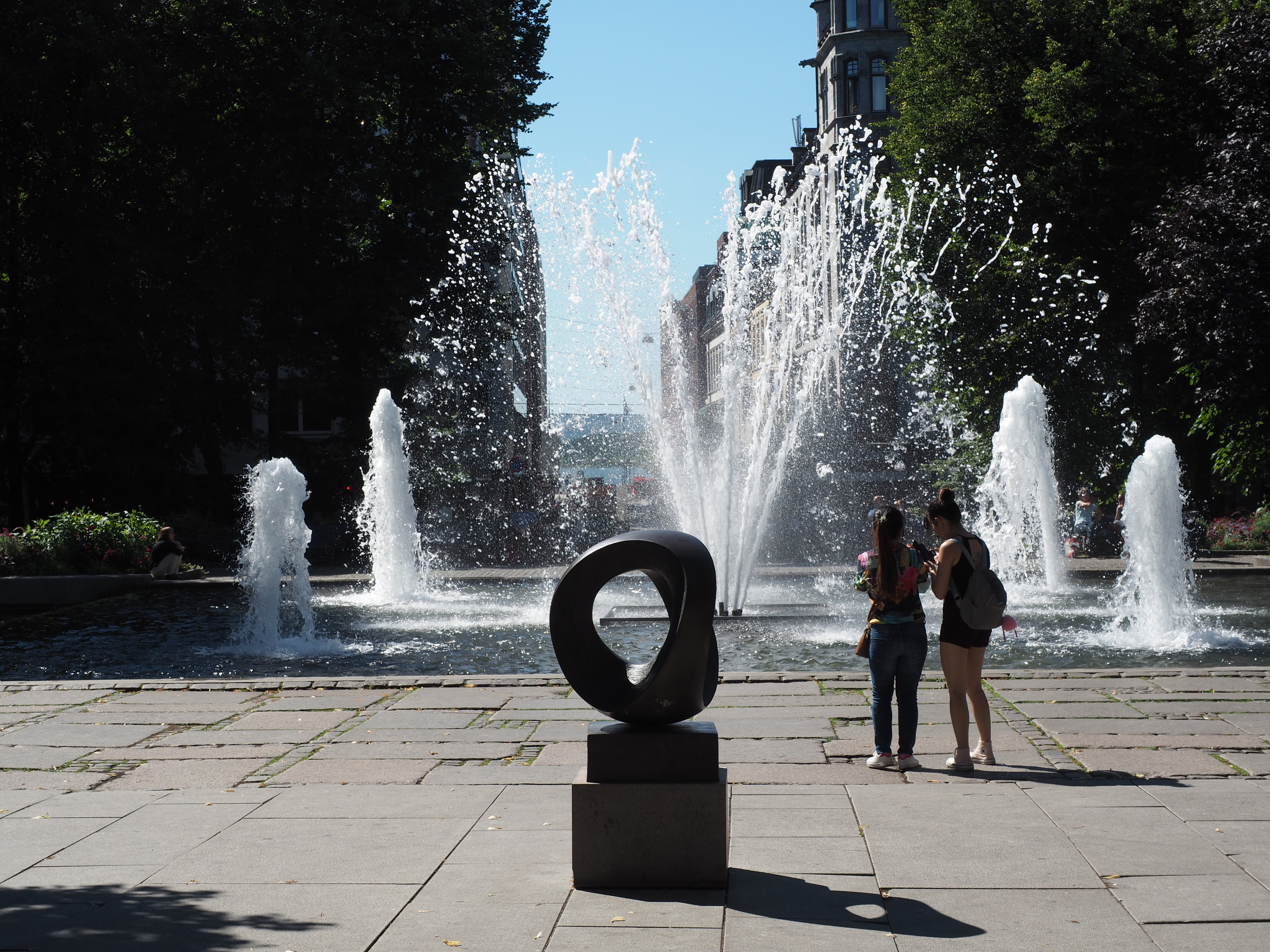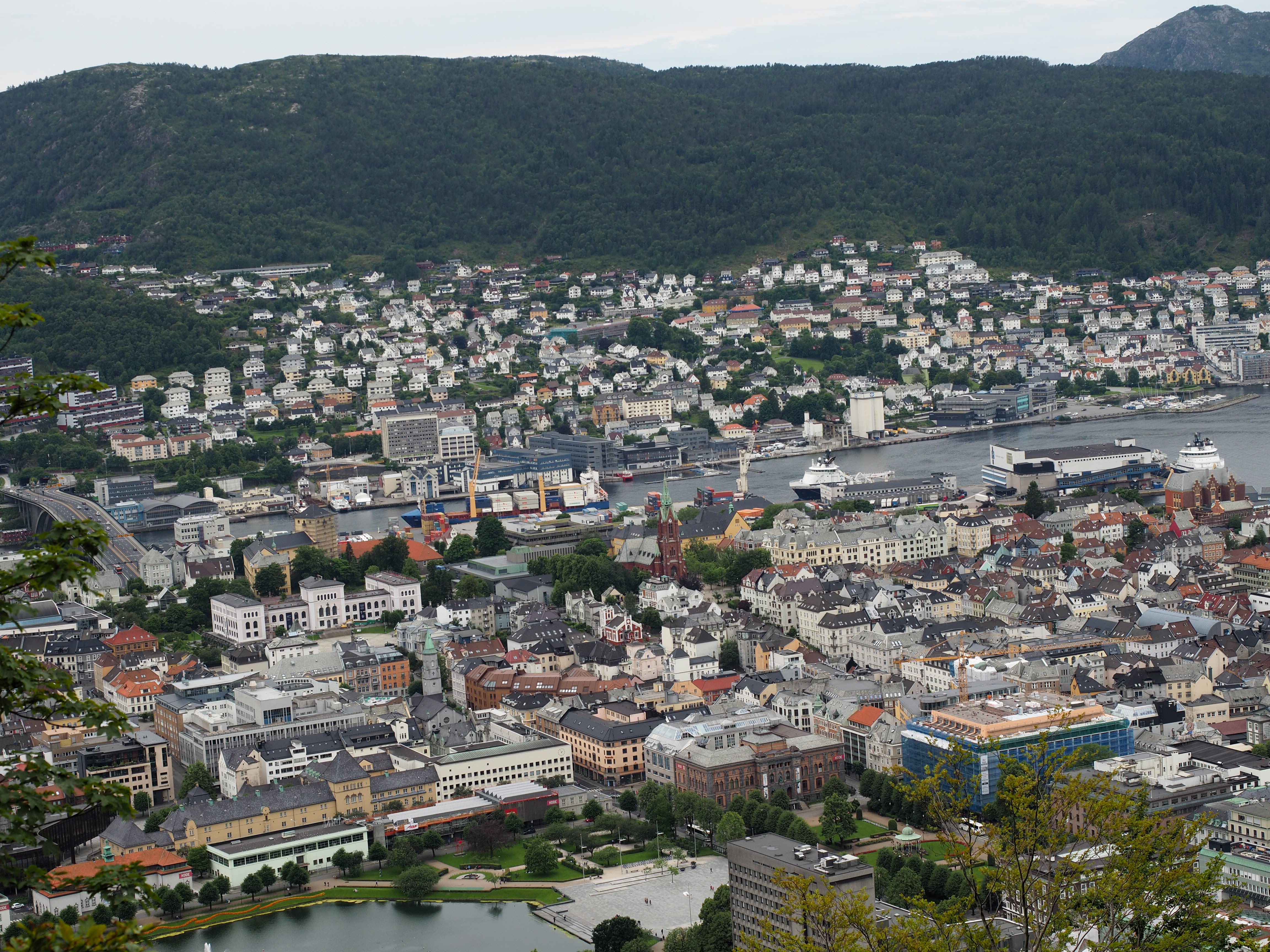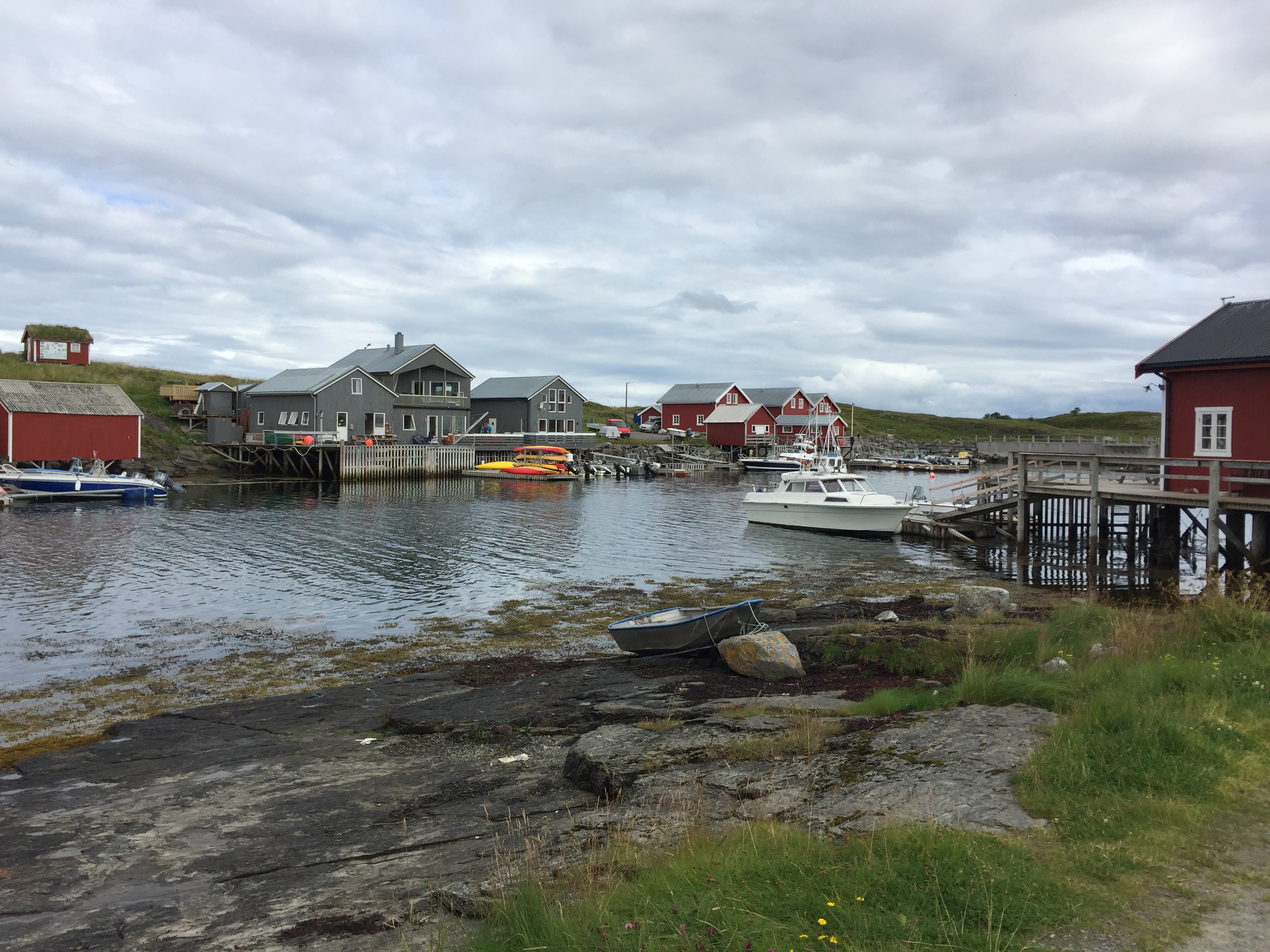Norway is known for its stunning fjords and mountains and outdoorsy people. Included in this trip is a ride on the famous Flam Railway on your way from Oslo to Bergen, also by rail. This trip includes a visit to the famous Geirangerfjord fjord, considered the most beautiful fjord in the world and one of Norway's many UNESCO World Heritage sites. You’ll also spend some quiet time in the magnificent archipelago of the Lofoten Islands, home to the largest coral reef in the world. Depending on the time of year, you can walk the pristine beaches, admire the peaks that dominate the skyline and maybe even catch a glimpse of the northern lights.You get there from Bergen and back on the Hurtigruten Coastal Ferry: an adventure all on its own.
Highlights
• Spend time in Oslo, a global city and known for its green spaces and museum, including the Norwegian Maritime Museum and the Viking Ship Museum.
• Take the famous Flam Railway train to Bergen. Roaring waterfalls, steep mountainsides and narrow fjords, the Flåm Railway is known as one of the most beautiful train journeys in the world.
• Spend time in Bergen; a city surrounded by mountains and fjords. Visit Bryggen with it’s colourful wooden houses on the old wharf and take the Floibanan Funicular up Floyen Mountain for panoramic views and hiking trails.
• Board Hurtigruten’s Coastal Voyage
- Enjoy the view of the Geirangerfjord from Eagle road, the idyllic Eidsdal Lake and the spectacular Trollstigen hairpin road
- Take a guided cycling trip through the city centre of Trondheim
• Exit Hurtigruten’s Coastal Voyage on its 4th day in Stramsund to enjoy 4 nights at Nusfjord Arctic Resort
• Embark on Hurtigruten’s Coastal Voyage south to Bergen
- You can embark on a visit to the UNESCO Islands Vega Archipelago
- Take a bus from Kristiansund to Averoy and Molde, including the 8.2 km Atlantic Road – the “Engineering Feat of the Century”, and visit a stave church
And best of all? This is completely customizable - stay longer, visit more, visit less - it's all up to you, the experiences you want to have, and the amount of time you have to explore!
Day 1 - Depart Toronto and Arrive in Oslo, Norway, via Reykjavik
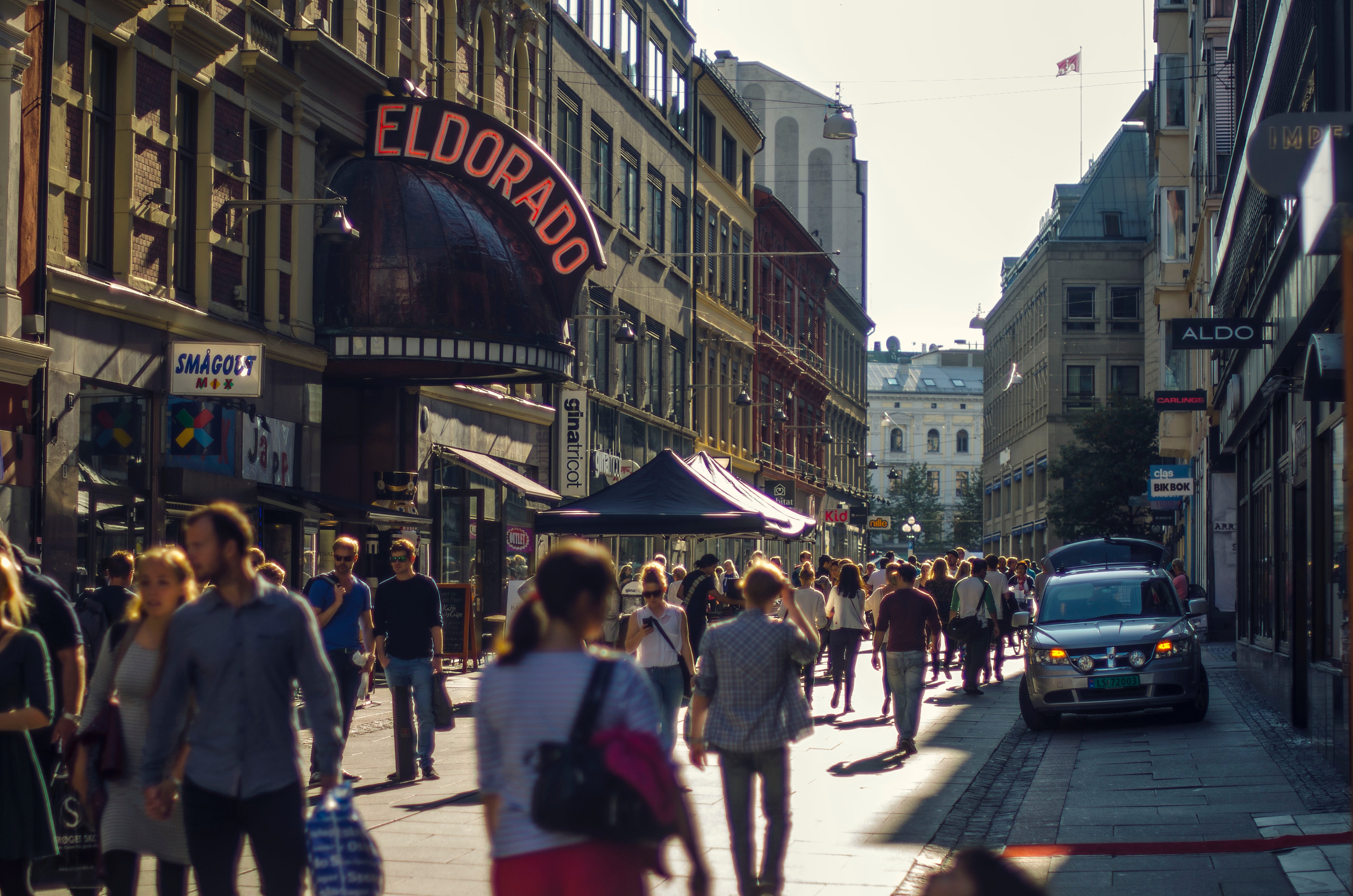
After a private transfer to your hotel, check in and get settled in. For those arriving early, we recommend exploring Oslo by foot, spending the afternoon at sights including the Munch Museum, Akershus fortress, Oslo Opera House, and the Aker Brygge area.
Day 2 - Explore the Highlights of Oslo
This morning, get an early start to explore the Norwegian capital at your own pace. We recommend booking a guided bus tour that will take you along the famous landmarks of the city. Highlights include the beautiful Vigeland Sculpture Park, the Royal Palace, Akershus fortress, and Oslo City Hall. Another option is to tour Oslo on your own visiting some of the above attractions, or others like the Viking Ship Museum, Fram Polar Ship Museum and Karl Johans street. You will then have the rest of the day to explore at your own leisure.
Vigeland Sculpture Park
Photo by Susan Tuckey, Penguins2PolarBears
This 80-acre park and see its 200 statues. Located in Frogner Park, it’s the world’s largest display of sculptures created by a single artist. Gustav Vigeland (1869–1943) created the collection of bronze, iron, and granite statues that now stand in this open-air “gallery”. From here, head down to Bygdøy island, where you’ll find many of Oslo’s museums.
Viking Museum

This museum is home to the best-preserved Viking ships in the world, some of which date back to the 9th century. It’s a sparse museum (the focus really is on the ships) but the burial ships (as well as the preserved tools and carts from the Middle Ages) are incredibly rare and worth seeing for yourself. The museum offers a short film and as well, though the free audio guide is the best way to make the most out of your visit. Huk Aveny 35, +47 22 13 52 80, khm.uio.no/besok-oss/vikingskipshuset. Open daily from 9am–6pm in the summer and 10am–4pm in the winter. Admission is 120 NOK for adults and free for kids under 18.
Norwegian Folk Museum
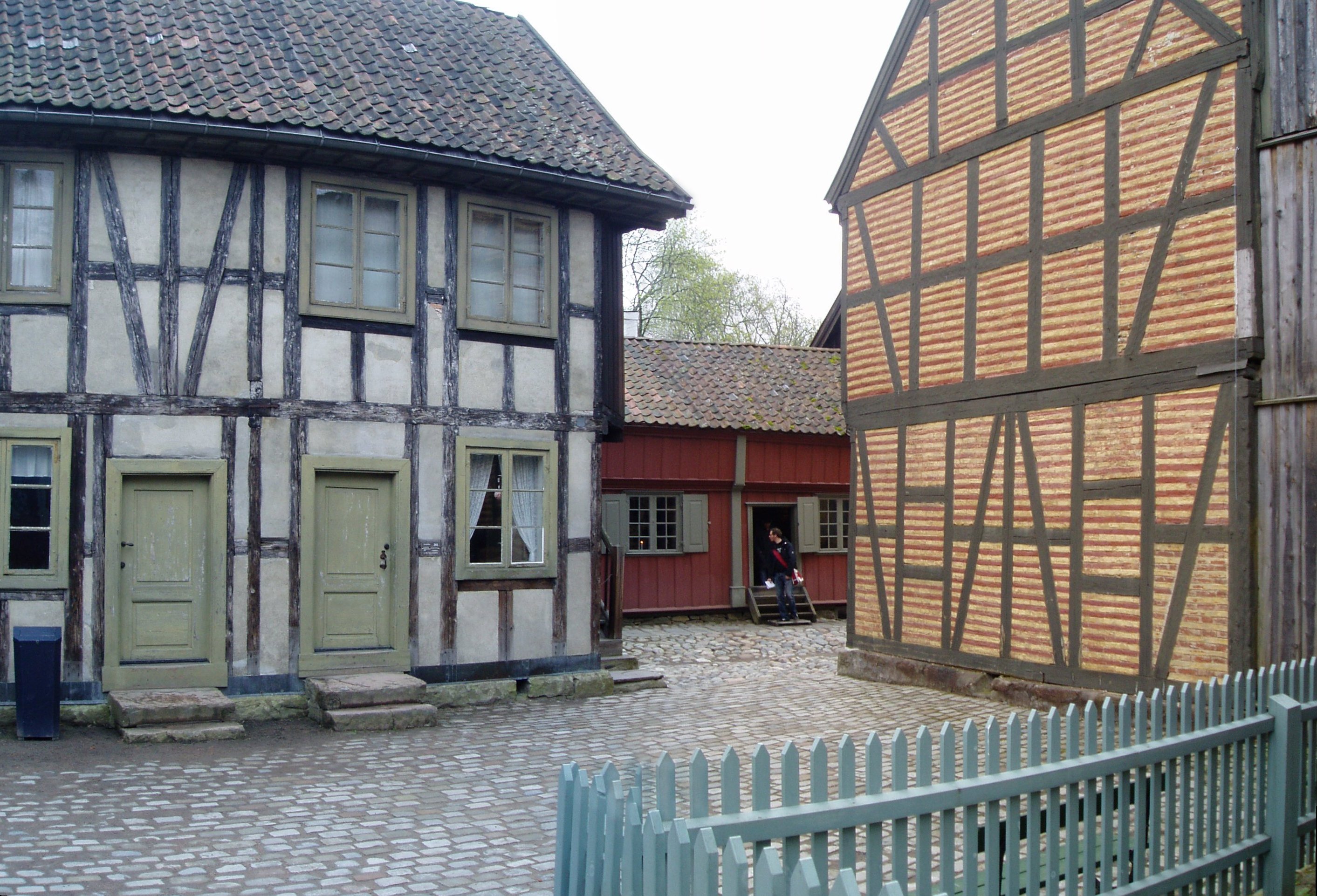
Also not far from the Viking Museum is the Norwegian Museum of Cultural History
.
It has a collection of over 150 buildings from various periods throughout Norwegian history. It’s an open-air museum, so you can explore both the interior and exterior of many of the buildings, some of which date back to the 12th century. The most impressive of its exhibitions is Gol Stave Church, an intricately carved wooden church constructed in 1157. The museum also has a large photographic archive as well as tons of historic artifacts, documents, tools, and more. Museumsveien 10, +47 22 12 37 00, norskfolkemuseum.no. Open daily from 11am–4pm. Admission is 160 NOK.
Visit the Fram Museum
As a northern country used to frigid temperatures and harsh winters, polar exploration is a field intricately woven into Norwegian history. This museum highlights that history, focusing on Norway’s contributions to polar exploration. The centerpiece of the museum is the Fram, the world’s first ice-breaking ship. The ship was used between 1893 and 1912 and is actually made of wood. The Fram made trips to both North and South Poles and sailed farther north and south than any other wooden ship in history. The museum is incredibly detailed; there’s a lot of photographs, artifacts, tools, and tons of information. It’s a unique look into Norwegian culture through the lens of exploration. Bygdøynesveien 39, +47 23 28 29 50, frammuseum.no. Open daily 10am–6pm. Admission is 120 NOK.
Visit the Holocaust Center
Established in 2001, this museum highlights the experiences of Norwegian Jews (as well as the persecution of other religious minorities). It’s located in the former residence of Vidkun Quisling, a Norwegian fascist who headed the Norwegian government under Nazi occupation between 1942-1945. It’s a somber and sobering place to visit but incredibly insightful with various exhibitions, photos, films, artifacts, and interviews from World War II and the German occupation of Norway. Huk Aveny 56, +47 23 10 62 00, hlsenteret.no. Open weekdays 9am–4pm. Admission is 70 NOK.
City Hall
End your day at City Hall, which is open to the public and free to enter. While it might not sound like an interesting sight, tours of the hall are will give you lots of insight into the city and its history. Most noteworthy are the hall’s twenty murals and works of art. They depict everything from traditional Norwegian life to the Nazi occupation. Also highlighted here is the history of the Nobel Peace Prize. It’s awarded here annually (the other Nobel Prizes are awarded in Stockholm, Sweden). Rådhusplassen 1, +47 23 46 12 00, oslo.kommune.no/radhuset. Open Sunday-Thursday from 9am-4pm. Admission is free.
Wander Akershus Fortress
Originally built in 1290, Akershus Fortress is a medieval fortress that evolved into a Renaissance palace under Danish King Christian IV. Currently, it’s used as an office for the prime minister. It was built for protection and the fortress has never successfully been besieged (though it did surrender to the Nazis during World War II). Inside the fort is a military museum as well as a museum dedicated to the Norwegian resistance during World War II. In the summer you can take a guided tour and there are also often events here as well (mostly concerts). Check the website to see if anything is occurring during your visit. Entrance to the fortress is free while access to the museums and the castle come at a price. The fortress is open May-Sep: 06:00 – 21:00 and Oct-Apr: 07:00 – 21:00.
The entrance to the castle costs 100 NOK. Opening hours of the castle are May-Sep: 10:00 – 16:00 (Mon-Sat), 12:00 – 16:00 (Sun); Oct-Apr: 12:00 – 17:00 (Sat-Sun).
Oslo Cathedral
Oslo Cathedral is open Mon-Thu & Sat-Sun from 10:00 – 16:00 and on Friday from 16 till 6 in the morning on Saturday. The entrance is free.
Karl Johans Gate
Photo by Susan Tuckey, Penguins2PolarBears
The impressive Karl Johans Gate (popularly known as just Karl Johan) is Norway’s most well-known and busiest thoroughfare. It runs for a little over 1 kilometer from the Central Station to the Royal Palace. The street is flanked by grand Neoclassical buildings on both sides and is also home to the delightful Studenterlunden Park.
Many important public buildings and institutions are located here such as the National Theater, the Norwegian Parliament building, and the old campus of the University of Oslo (now home to the Faculty of Law). The Norwegian Parliament building (Stortinget) is one of the most beautiful parliament buildings that I’ve seen and has a graceful yellow-brick Neo-Romanesque exterior.
Aker Brygge & Tjuvholmen
When spending a weekend in Oslo, a visit to the vibrant borough of Aker Brygge is one of the top things to do. Aker Brygge was formerly dominated by a big shipyard that closed in 1982, freeing up a potentially attractive area on Oslo’s harborfront. Since then, Aker Brygge has been transformed in Oslo’s most chic entertainment hub and features the biggest concentration of restaurants in the city. Many of the old shipyard warehouses have been restored and you can see a juxtaposition of old and new architecture here. Aker Brygge is a delightful setting in which to enjoy a chilled beer at the quayside or just to take a stroll along the promenade and soak up the atmosphere.
The islet of Tjuvholmen (literally Thief’s Islet) lies adjacent to Aker Brygge. Like Aker Brygge, it has undergone massive redevelopment and is home to some exemplary examples of modern architecture and a swathe of high-end condos. You can find numerous fancy bars and restaurants here too. A notable point of interest in Tjuvholmen is the Astrup Fearnley Museum of Modern Art, one of Norway’s leading museums of contemporary art. If you’re visiting in the summer, there is a little man-made beach and some docks to jump off and go swimming.
Grünerløkka District
Grünerløkka is a former gritty working-class district that has undergone a massive facelift and renaissance in the last few decades. With its high immigrant population, cool street art, trendy bars, cafes, restaurants, and vintage shops, this edgy and urban district is perhaps the most interesting area of Oslo. Here, the tourist hordes thin, the streets broaden and you can tap into a Norwegian living vibe that manages to be laid-back yet sophisticated. It’s no surprise that Grünerløkka is sometimes called ‘Soho of Oslo’. On a Scandinavian scale, Grünerløkka can be compared to Södermalm in Stockholm and Vesterbro in Copenhagen.
INSIDER TIP: If you’re planning on purchasing wine or hard liquor in Oslo, you’ll have to go to one of the Vinmonopolet stores. Norway has a monopolized market where only the state-run retail Vinmonopolet stores are permitted to sell wine and hard liquor. Light beers and ciders below 4.7 percent alcohol can be purchased in supermarkets.
Oslo Eating Options
(Tours be booked when availability opens up for time of travel)
- The Taste of Oslo Tour: Get a local's perspective on Oslo's exciting food scene, and go off the beaten path, on this food tour. Hear from your guide about the gastronomic revolution taking place in the Nordic food scene as you walk from the city center to the trendy district of Grunerløkka. Along the way stop in at several different eateries and sample a handful of tastings of local-favorite dishes including seasonal meats, seafood delicacies, and a few drinks. Read more about The Taste of Oslo - https://www.viator.com/tours/Oslo/The-Oslo-Gourmet-Tour/d902-6027P7 $205 per person - 4 hours
- Get Tasty: The Ultimate Oslo Street food Experience Tour (Friday drop-in) $154 per person 3 hours 30 minutes - or private $187 per person
- Pastries: Delightfully fresh brew and pastries at the retro Fuglen Espresso Bar, one of the best cafes in Oslo.
-
Dinner:
A bevy of great eateries in both Aker Brygge and Tjuvholmen, making either of them the ideal location for having dinner on your first day in Oslo. Døgnvill Burger serves an amazing array of succulent burgers.
Oslo is also a great place to try seafood and Lofoten Fiskerestaurant is one of the very best places in town to try favorites such as halibut, seabass, and baked salmon. If you’ve got serious cojones, you can even pre-order the lutefisk (dried stockfish that has been soaked in lye and then poached in broth), a Norwegian delicacy. I’ve tried it and can guarantee that it’s definitely an acquired taste.
Lorry is a pretty good restaurant where you can try reindeer and the Norwegian national dish of fårikål (pieces of mutton or lamb served with cabbage, whole black pepper, and potatoes). I really enjoy devouring mutton and this dish didn’t disappoint. Otherwise, another alternative is Mamma Pizza, a fantastic Italian joint.
Pakistanis constitute the single largest ethnic minority in Oslo. Take advantage of this by dining in one of the city’s many Pakistani/Indian themed restaurants. Mehfel is one of the absolute best places in the downtown area and serves some mouth-watering chicken and lamb dishes.
Day 3 – Norway in a Nutshell - The Flam Railway
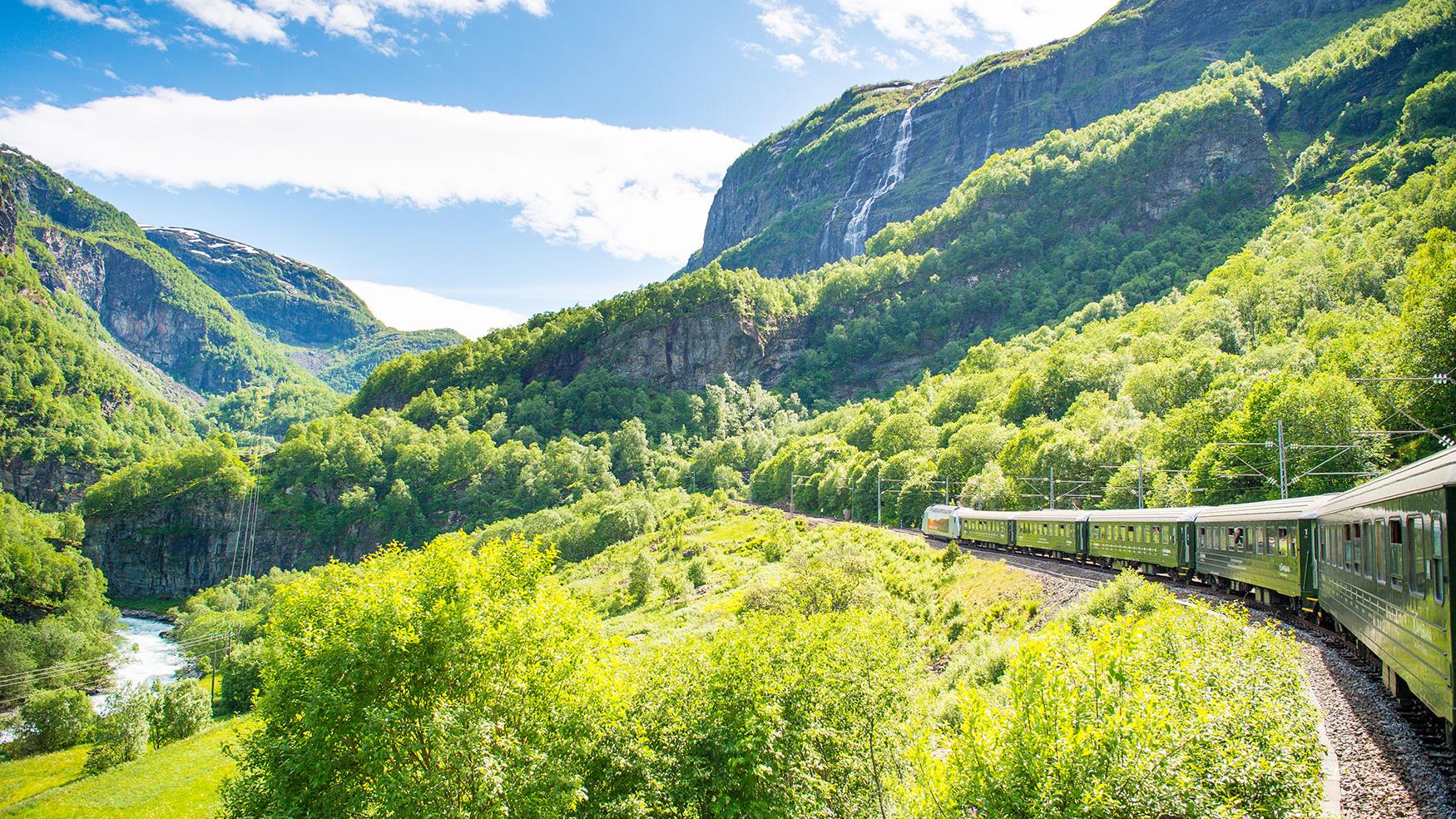
Get an early start and head to Oslo Central Station, where you’ll begin the Norway in a Nutshell® railway journey towards Bergen, with two overnight stops in Flåm. This train ride takes you over Norway’s “mountainous rooftops”, through charming villages like Gol and Geilo. In Myrdal, you’ll switch trains to the famous Flåm Railway (Flåmsbana) for an incredible ride to the beautiful village of Flåm. Enjoy a relaxing day in Flåm, where you can follow one of the many hiking trails in the mountains around the village.
Travel by Regional Train from Oslo to Myrdal (4.5 hours) and board the Flam Railway train for a 1 hour trip to Flam. The train from Myrdal train station to Bergen takes 2 hours.The Flåm Railway has been described as one of the most beautiful train journeys in the world and is one of the leading tourist attractions in Norway. The train runs from the end of Aurlandsfjord, a tributary of the Sognefjord, up to the high mountains at Myrdal station. The journey features the finest aspects of the stunning scenery of Western Norway. From the comfort of a vintage train compartment, you can enjoy the changing scenery of the Flåm Valley. Before ascending into the more impassable sections of the valley, the train runs through agricultural landscapes, the old Flåm village centre and the old church. The sparkling blue river follows the railway for large parts of the trip, and you will pass small farms in locations you’d think no one could live. The train takes a five-minute photo stop at the Kjosfossen waterfall where you can disembark and go out onto the platform. Watch out for Huldra – a beautiful mythological creature with long hair wearing a red dress!
Day 4 - Explore Scenic Flam
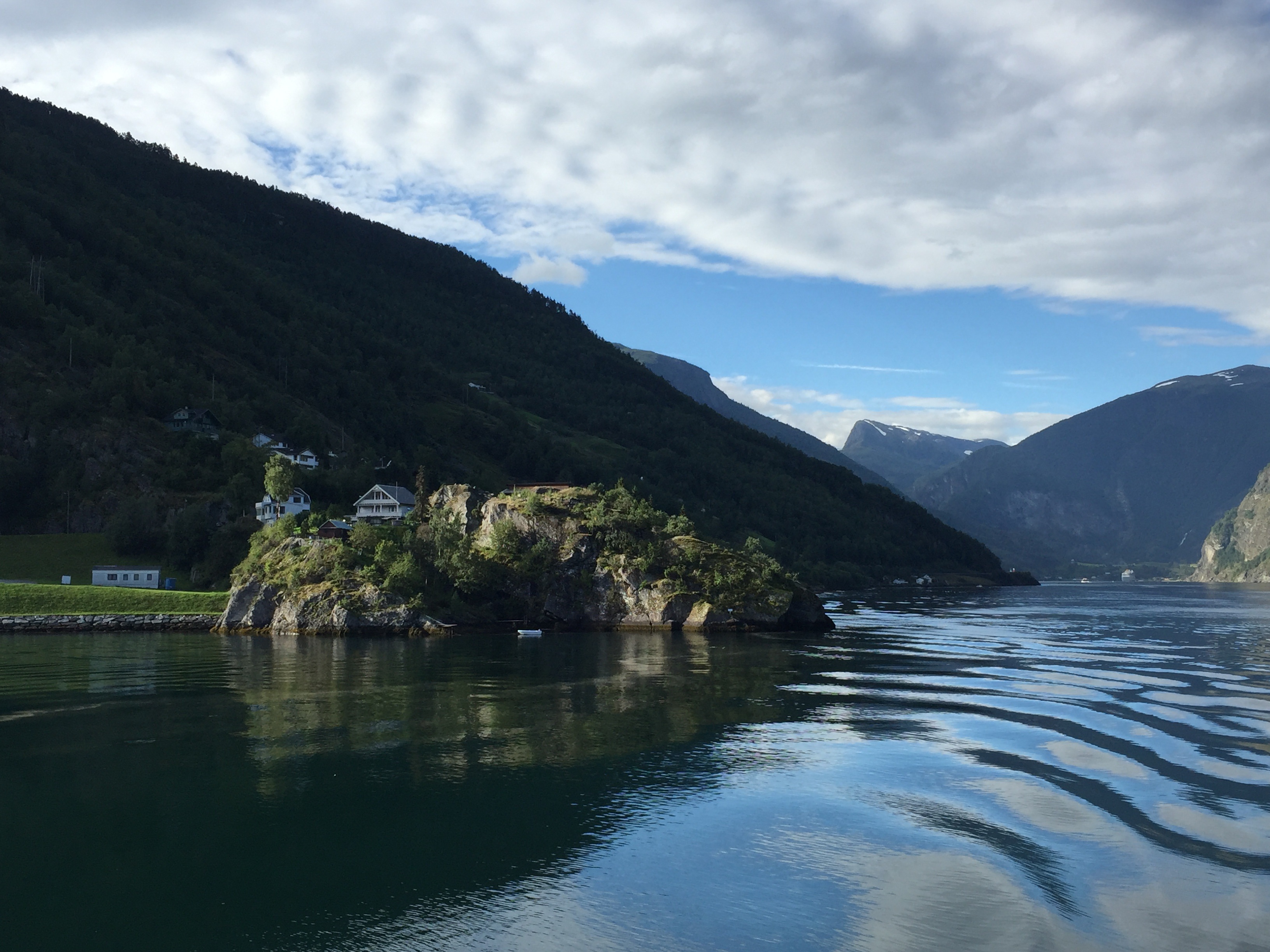
Spend the day exploring the beauty of Flåm and its surroundings. In this tour package, you get free admission to the Flåm Railway Documentation Centre, where you can learn about the construction of this railway. It is also recommended to join an optional tour to the Stegastein viewpoint. The viewing platform extends about 30 metres from the cliffside and 650 metres above the fjords, offering extraordinary and unbeatable views. For those who want to explore the fjords even further, you can enjoy an optional fjord safari or kayaking tour.
Day 5 - Norway in a Nutshell to Bergen
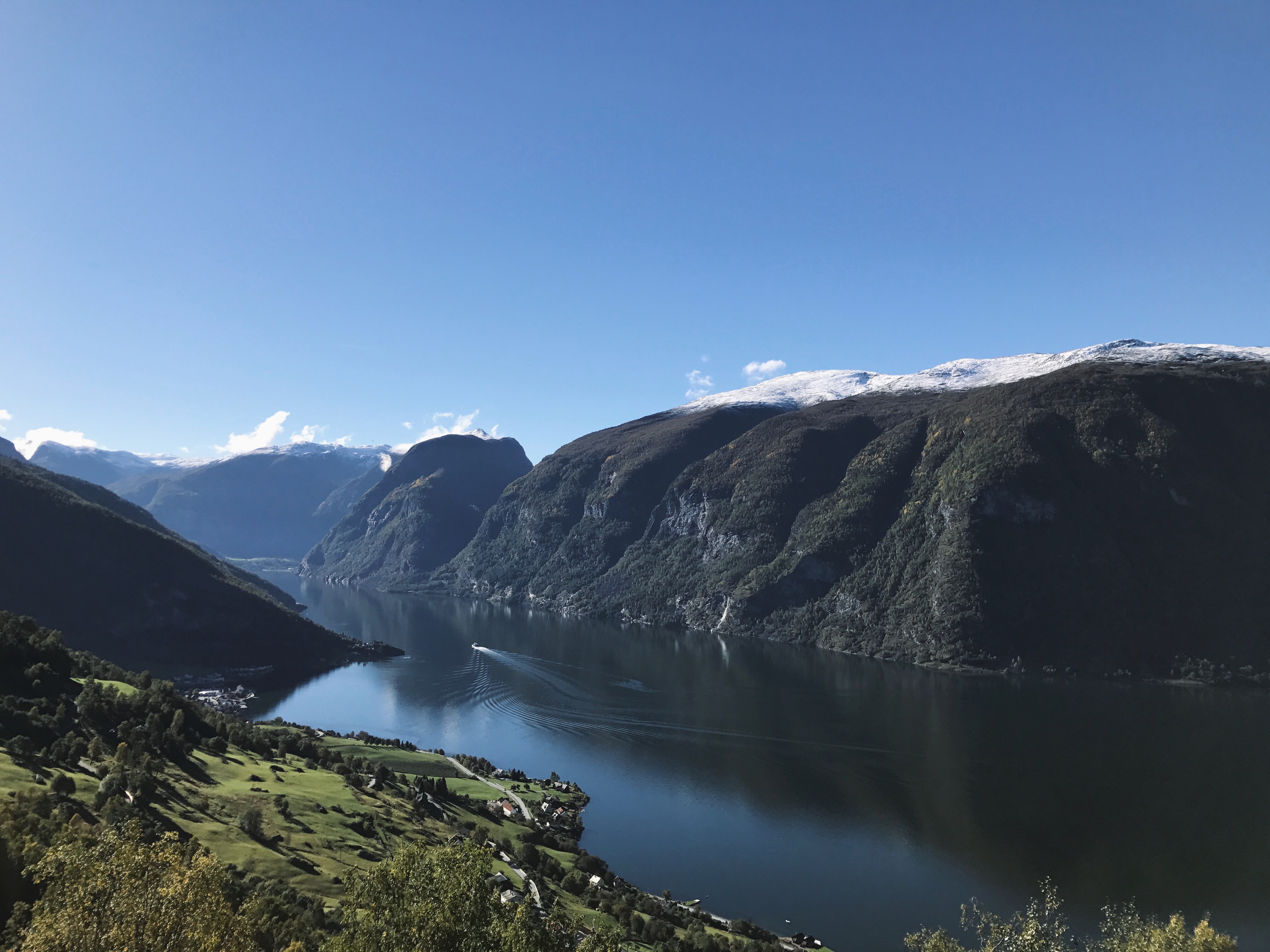
At noon, you’ll board a boat to sail through Aurlandsfjord into the World Heritage-listed Nærøyfjord, the narrowest fjord in all of Europe. This is perhaps the most beautiful arm of Sognefjord, with its mighty waterfalls and small farms clinging to the steep mountainsides. The boat docks in Gudvangen, from where you’ll be transported by bus up Stalheimskleiva, Northern Europe’s steepest stretch of road. After a thrilling ride around 13 hairpin bends, you will continue to Voss to board the train for the last stretch of the journey to Bergen.
Day 6 - Capital of the Fjords
Photo by Susan Tuckey, Penguins2PolarBears
Despite being an international city, Bergen, “The Capital of the Fjords”, has all the charms of a small town. Here you’ll find Bryggen, a UNESCO World Heritage site, along with remarkably preserved old houses, a lively fish and flower market, cable cars offering stunning views, great museums and more. We recommend riding the Fløibanen Funicular to Mount Fløyen to enjoy the panoramic view of the city or a cable car up Mt. Ulriken. Bergen is also known for its museums dedicated to history within trade and fisheries, architecture, musical art and contemporary art.
Bergen is surrounded by seven mountains and a visit to one of the mountains is a must! Take the funicular up to the top of Mount Fløyen and enjoy the great view of Bergen and the surrounding area. The large viewpoint is the best spot for taking panoramic pictures of the city. There is also a number of nice trails and paths for hiking. The highest mountain can be reached with Ulriken Cable Car just outside the city center. From Fløyen you can take the funicular back down to the city center or walk down, amongst old wooden houses, narrow alleyways and cobbled streets. The walk will take you about 45 minutes. Once down in the city, continue along Bryggen. The old wooden houses on Bryggen is part of UNESCO's list of world heritage. Enjoy the atmosphere of olden days when walking into the narrow alleyways. Have a drink and a Norwegian “skillingsbolle” (cinnamon bun) at Baker Brun and visit the small shops and galleries.
At the Hanseatic Museum, you can see how the German merchants from The Hanseatic League lived and worked in the 18th century.
Across the road from the museum you will find the Fish Market. Taste freshly cooked prawns, Norwegian strawberries or just look at the wide variety of fish and shellfish. For dinner try Bryggen Tracteursted, inspired by the traditions from Bergen and Hanseatic cooking. For a great winelist, try Altona Winbar. Meet the locals at Storm Bar or Cafè Opera for a light snack and a drink. Both located close to the theatre.
Visit to the Bergen Aquarium. Enjoy the shark tunnel, the crocodiles and feeding of penguins and seals.
Continue your day with a visit to one of Bergen's many museums. The new Edvard Munch exhibition at Kode - the Art Museum of Bergen is very popular. The best selection of souvenirs you'll find at Bryggen.
My suggestion for dinner: Dr. Wiesener, Nye Sandviksveien 17A, 5003 Bergen - try comfort food and traditional Plukkfish
Day 7 – Board the Hurtigruten Coastal Voyage – 3 nights / 4 days
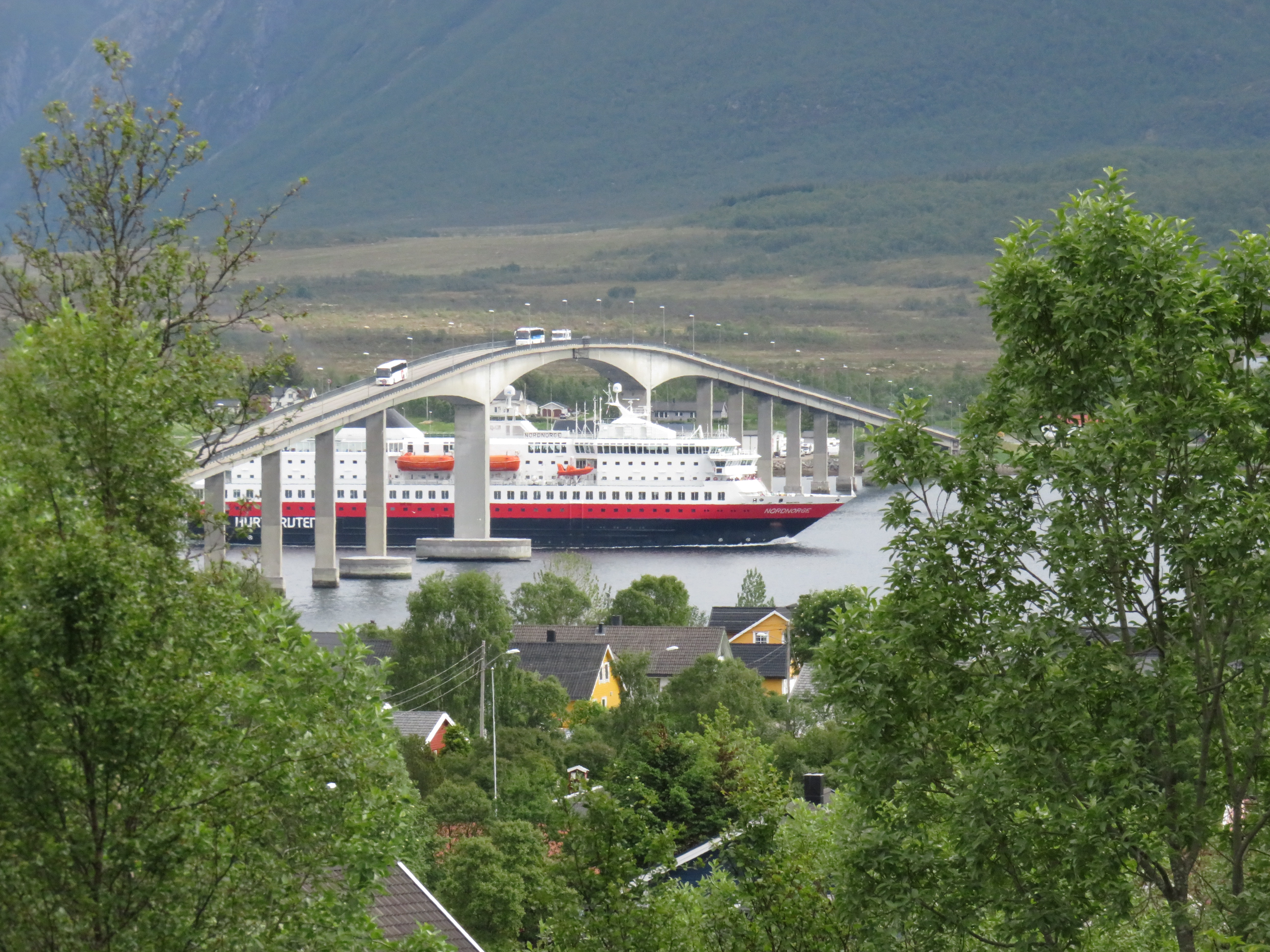
Michael Fleczoreck on Unsplash
The iconic backbone of cruising coastal Norway: This is the famous classic voyage that has connected 34 remote communities along Norway’s coastline for more than 125 years. You’ll travel aboard a national icon and be a part of Norway’s living history. You’ll be partaking in a part of this voyage for three nights, each way, as your transportation to Stamsund and return back to Bergen. In between those three nights, you'll be at the Nusfjord Arctic Resort in the Lofoten Islands.
Day 8 – Excursion to Geirangerfjord and Trollstigen Pass
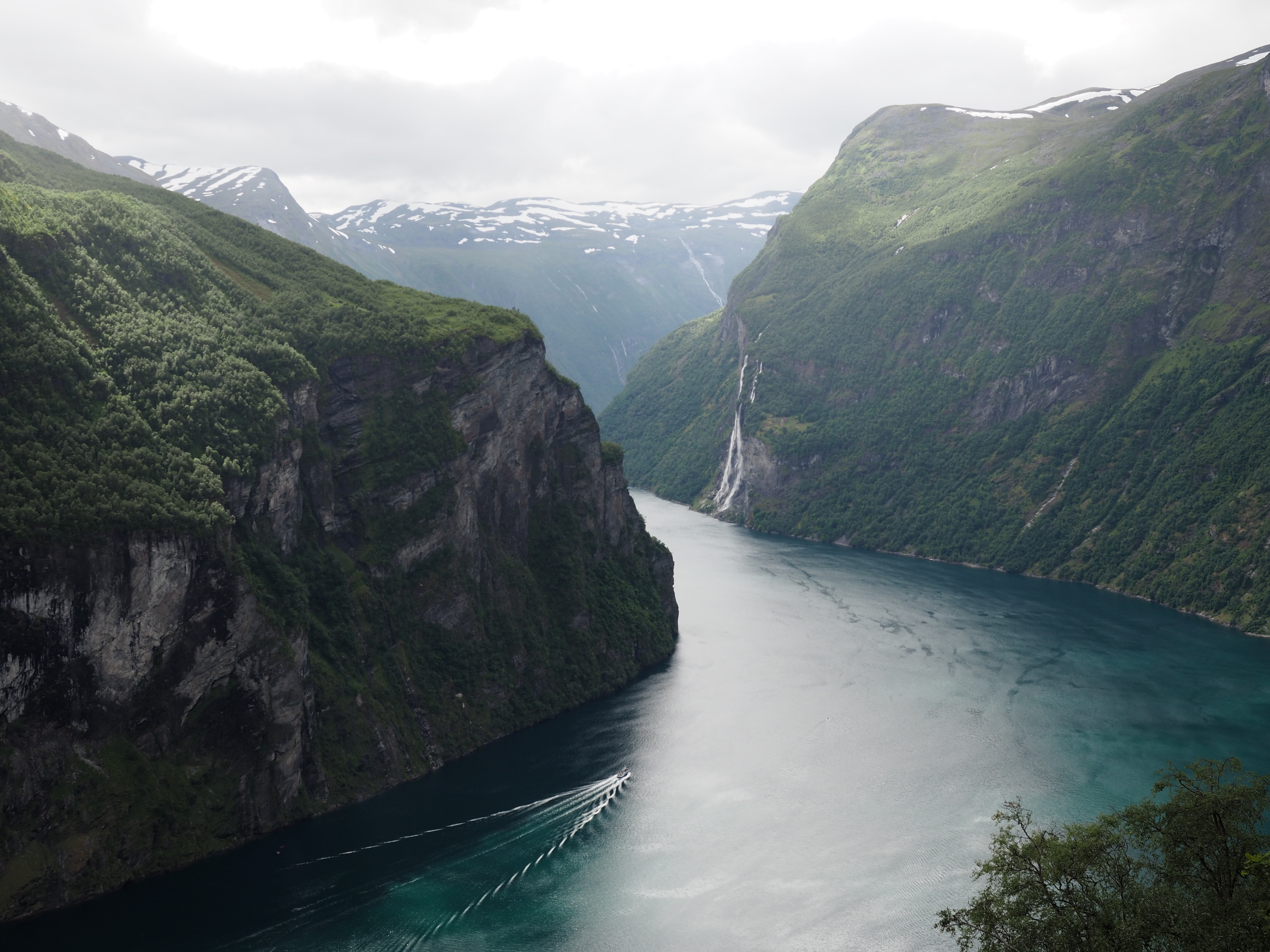
Photo by Susan Tuckey, Penguins2PolarBears
Enjoy the view of the Geirangerfjord from Eagle road, the idyllic Eidsdal Lake and the spectacular Trollstigen hairpin road.
Day 9 – Trondheim Cycling Excursion (Optional)
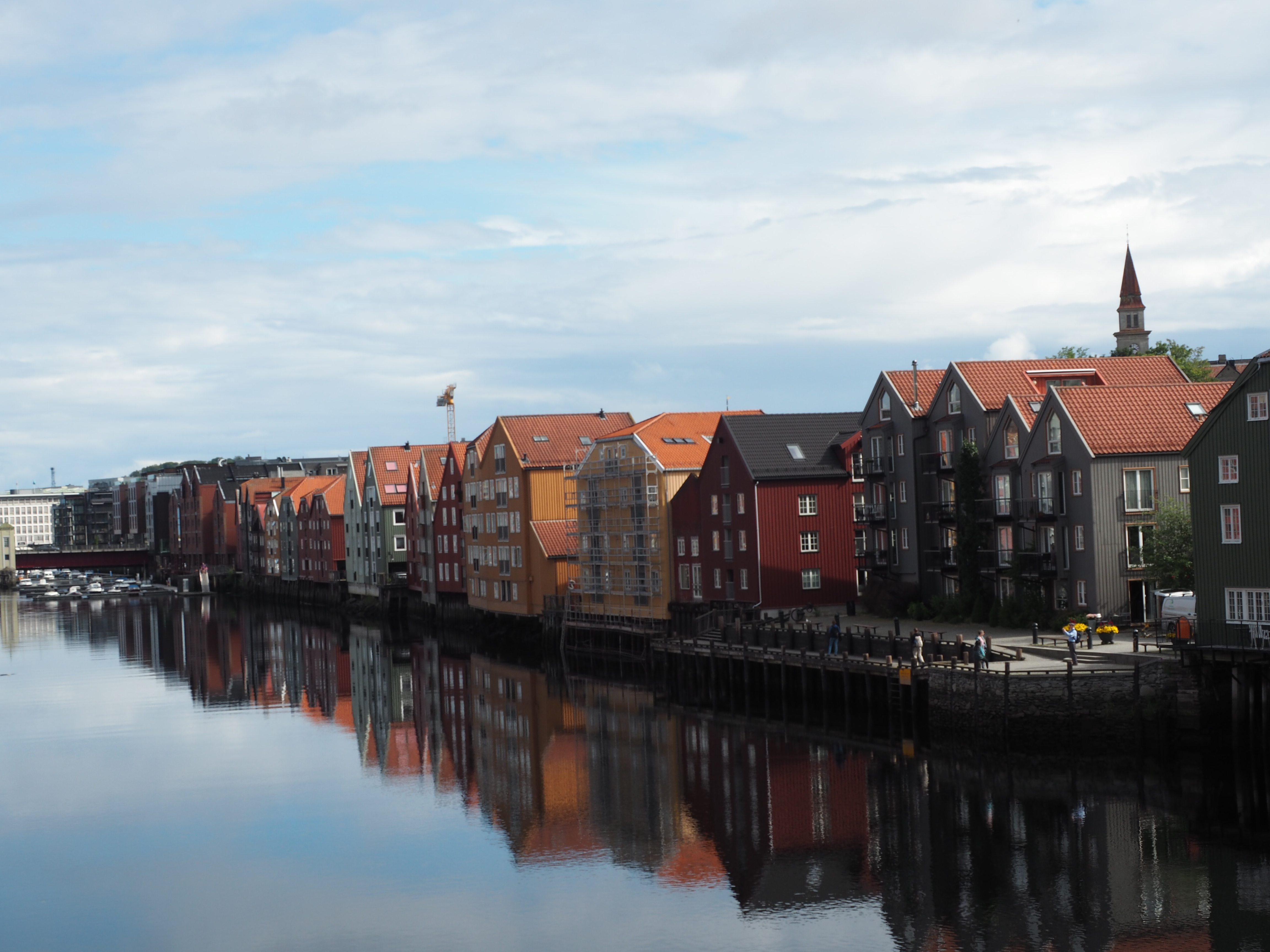
Photo by Susan Tuckey, Penguins2PolarBears
Guided cycling trip through the city centre of Trondheim - can be booked with Hurtigruten.
Day 10-13 – Exit Hurtigruten Coastal Voyage at Stamsund to stay at Nusfjord Arctic Resort for 4 nights
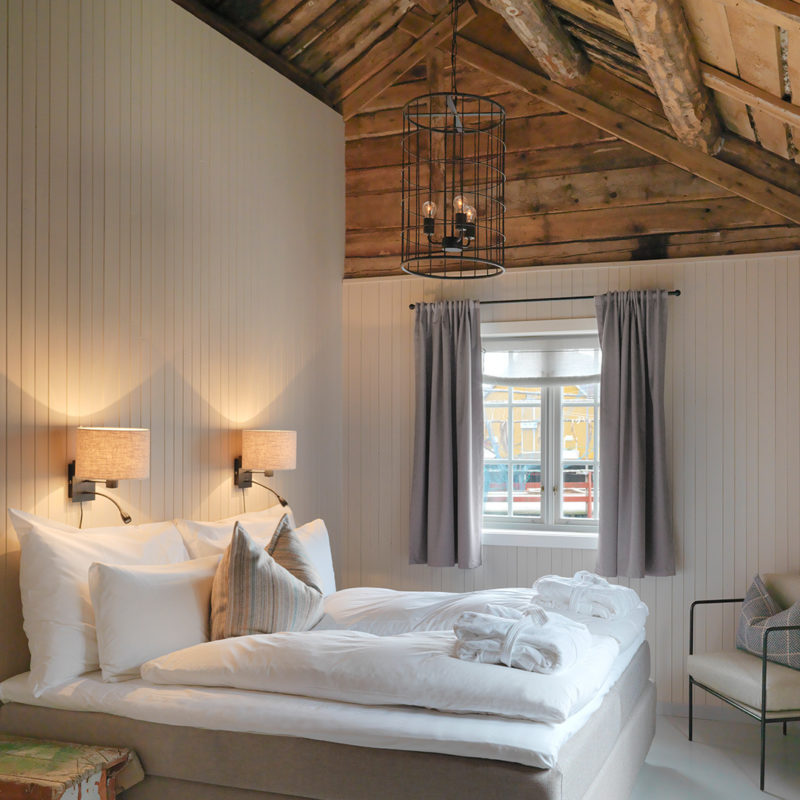
Private transfer to Nusfjord Arctic Resort. Nusfjord Arctic Resort is situated in the secluded and tranquil fishing village of Nusfjord in Lofoten, Norway. As you pass the spectacular mountains passes of Flakstad, breathe in the salty winds of the northern sea, and prepare for immersing yourself in a truly authentic experience of the Lofoten islands.
Optional Activities to pre-book and choose from (depending on time of year):
These activities are available at the resort but have to be booked and paid for separately:
• Rib safari – Can be done all year. Best between April – September.
• Spa and wellness – Can be done all year. Very beautiful to experience in all sorts of weather.
• Stand Up paddle – Only available in high season May – September.
• Kayak – Only available in high season May – September.
• Surfing – Can be done from February – October/November. This due to the polar nights were the days are dark from November – January. Surfing Is fun all year around. Here it only depends on preference.
• Photography – Can be done all year. Different motives in the different seasons. In the spring, summer and fall the nature is the focus. In the winter the nature and northern lights are in focus.
• Hiking – Can be done in April until September. Would not recommend doing October- March due to snow. Unless clients are very experienced with a good knowledge of the mountain. Best to do this activity in spring, summer and fall.
• Boat rentals – Can be done all year. Might be some cancelled rentals in the winter months due to winter storms. Best to do in March due to “Lofotfiske”. The big fishing season for cod.
• Fishing trip – Can be done all year. Best in March due to “Lofotfiske”. The big fishing season for cod.
Best month for the Northern lights is February. The northern lights shows of course the whole winter, but in my personal opinion its best after Christmas. The sky can have this clear moments in the night were you see the Northern lights dancing.
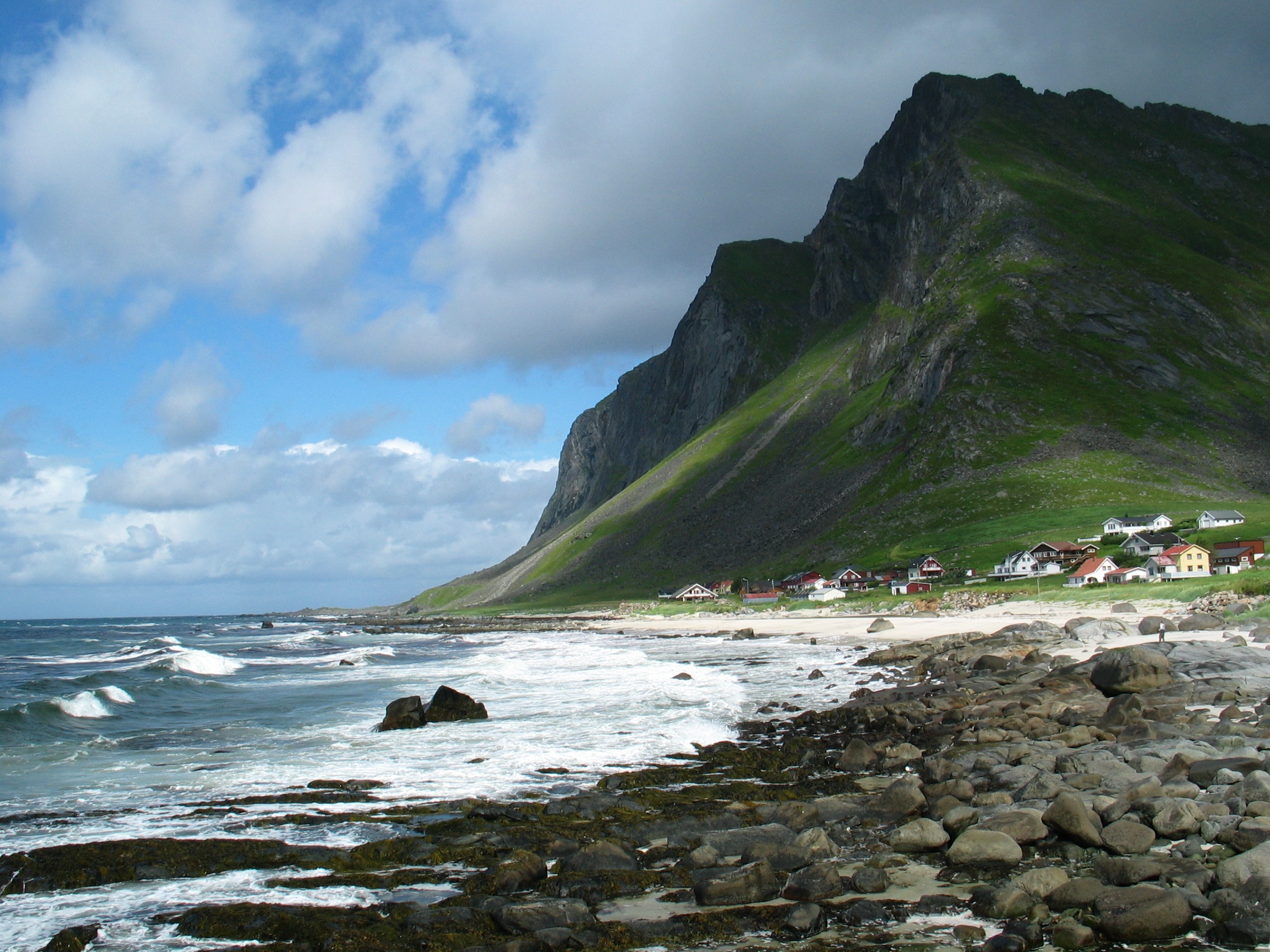
Day 14 – Private Transfer to Stamsund to board the Hurtigruten Coastal Voyage Southbound back to Bergen
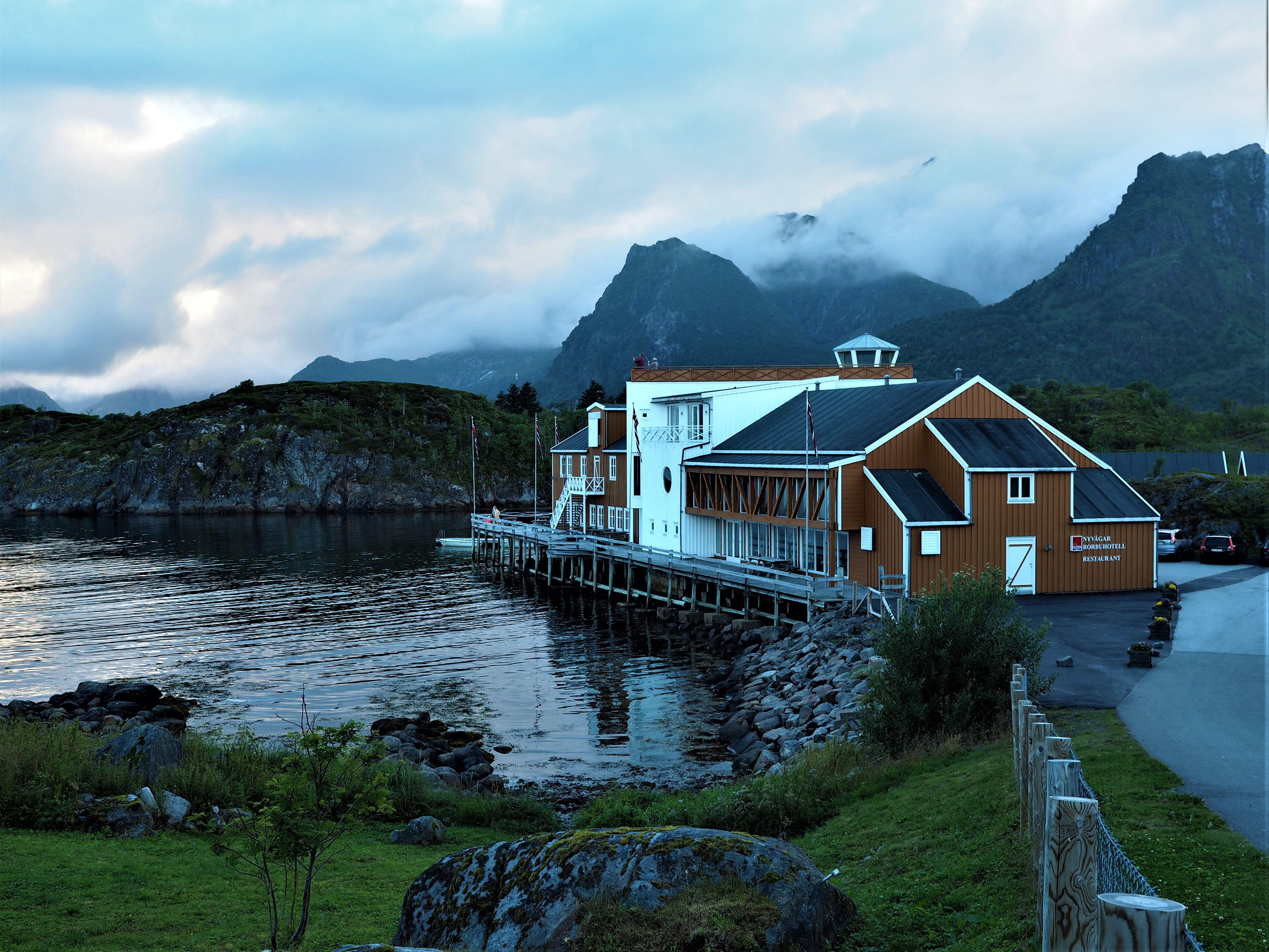
Photo by Susan Tuckey, Penguins2PolarBears
Excursion options include: UNESCO Islands Vega Archipelago (Sandnessjoen-Bronnoysund);
Photo by Susan Tuckey, Penguins2PolarBears
The Atlantic Road (Kristiansund-Molde)
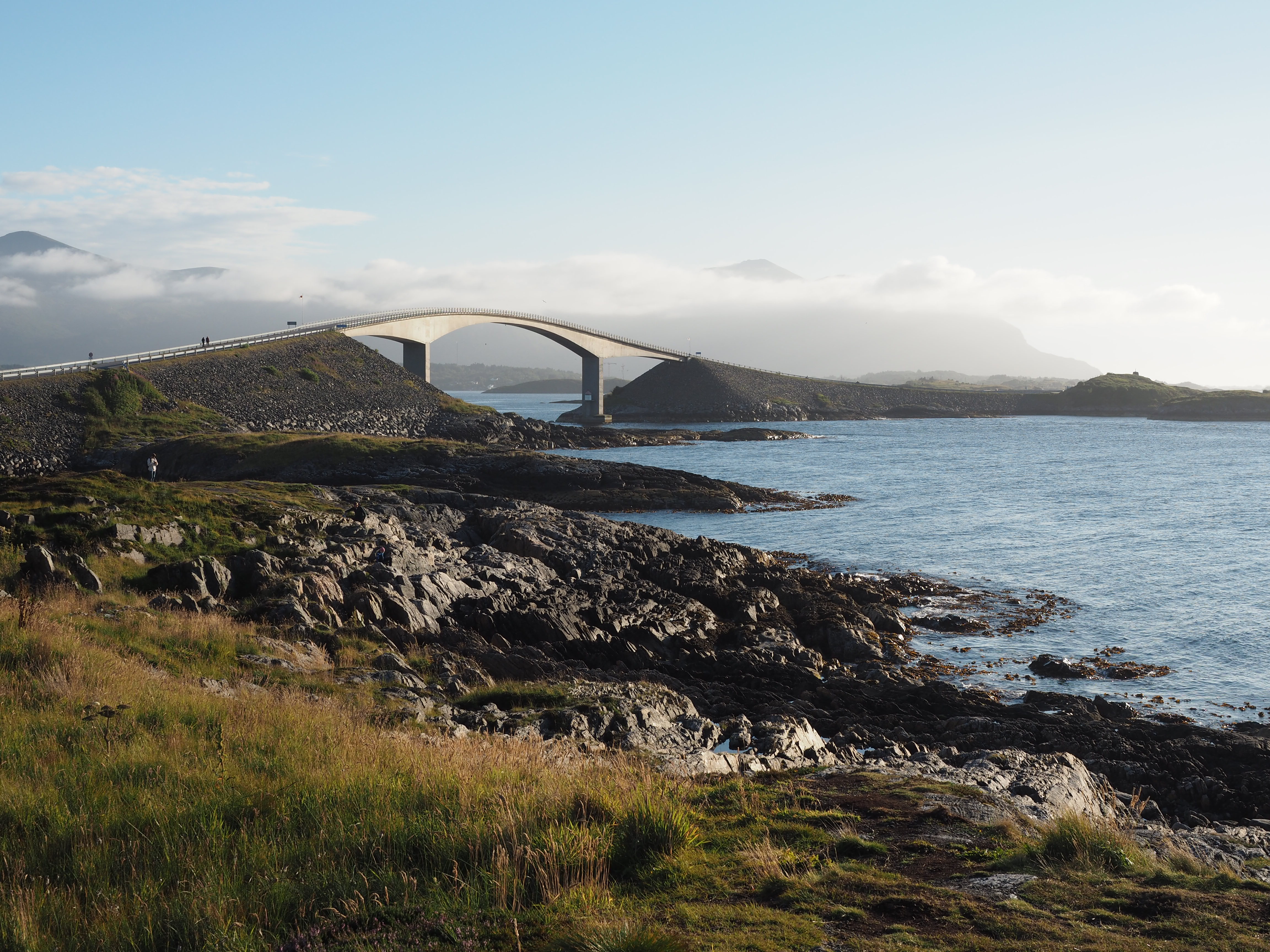
Day 17 – Transfer to Bergen Airport for Flights Home
Your ship will reach Bergen in the morning. Flights from 10 a.m. onward should give you plenty of time to get to the airport.
Sign up to my weekly newsletter for more travel inspiration or request a consultation below:

